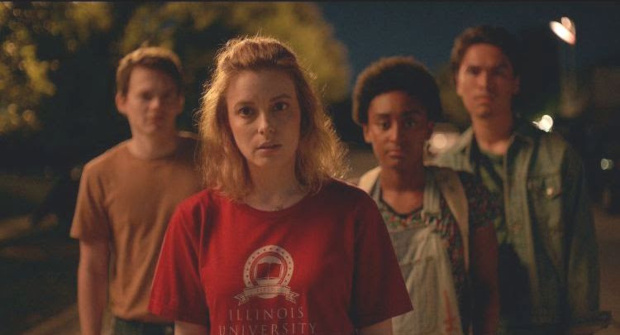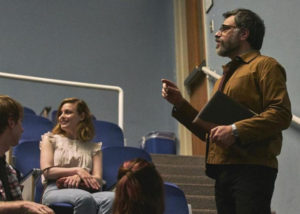
One thing about Kris Rey’s film I Used to Go Here is that films like it would have made its protagonist Kate (Gillian Jacobs) stay in her point A. That point A is Chicago and her eventual point B is Southern Illinois University in Carbondale. The journey happens five minutes into the film making her confront whether she is a failure or a success. Kate returns to her old alma mater to do a reading of her first novel. Events like this seem like an in and out affair. But I Used to Go Here tries to justify why a millennial would feel nostalgic about their old university town. This feature makes the town look good and makes the location feel like a distinct character. It takes time to show its main streets and its businesses that still have their old signage.
The same goes for the film’s depiction of Carbondale’s green residential streets, with houses that feel like they have their own history. The rest of the film, then, shows what happens as she steps onto those streets and meets the campus’ old and new characters. Kate’s former mentor David (Jemaine Clement) invited her to do a reading in his class. And afterwards, during drinks, she admits to him that her book is not selling as well as she prefers. The indie music accompanying the Carbondale montages stop. And here, the film delivers a realism relatable to people in the arts. She is, importantly, having a conversation with a man who, presumably, exists for her and his other students’ successes.
The film gets some commendation for exploring the power dynamics among characters. But either this college has bad departments or that the film depicting this college relies on clichés instead of unique specifics. First, that creative writing class is too big. Second, colleges often switch out artists in residence, and they work in different colleges while writing books in between teaching stints. I guess making David stay in SIU for fifteen years makes sense for him to develop an environment where he could groom students. And yes, that happens, but there has to be a way for a film to handle that topic in an indie dramedy while being sensitive towards it.
I Used to Go Here also make me look back at films about unsuccessful adult. And as an unsuccessful adult I wondered, when was the last time I liked something from that sub genre? That time was last month, with a film that makes us forget what subgenre it belongs to. And sure, maybe we must allocate some empathy when a protagonist acts irrationally, but the film must justify that irrationality. That, or write a character with imperfect but passable coping mechanisms or rational thought. Or maybe it’s that I’m watching a protagonist flail in front of unbelievably combative side characters. One that stays stay in bad situations like Kate does just so we can cringe at it. Stuff like this does not make for interesting cinema as it used to.
- Release Date: 8/7/2020

